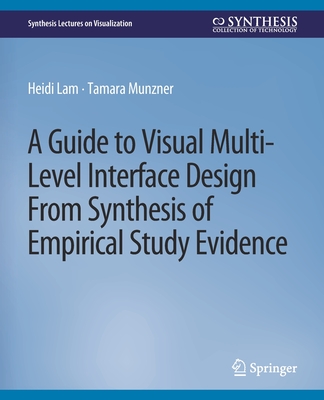You are here
Back to topA Guide to Visual Multi-Level Interface Design from Synthesis of Empirical Study Evidence (Synthesis Lectures on Visualization) (Paperback)
$29.99
Usually Ships in 1-5 Days
Description
Displaying multiple levels of data visually has been proposed to address the challenge of limited screen space. Although many previous empirical studies have addressed different aspects of this question, the information visualization research community does not currently have a clearly articulated consensus on how, when, or even if displaying data at multiple levels is effective. To shed more light on this complex topic, we conducted a systematic review of 22 existing multi-level interface studies to extract high-level design guidelines. To facilitate discussion, we cast our analysis findings into a four-point decision tree: (1) When are multi-level displays useful? (2) What should the higher visual levels display? (3) Should the different visual levels be displayed simultaneously, or one at a time? (4) Should the visual levels be embedded in a single display, or separated into multiple displays? Our analysis resulted in three design guidelines: (1) the number of levels in display anddata should match; (2) high visual levels should only display task-relevant information; (3) simultaneous display, rather than temporal switching, is suitable for tasks with multi-level answers. Table of Contents: Introduction / Terminology / Methodology / Summary of Studies / Decision 1: Single or Multi-level Interface? / Decision 2: How to Create the High-Level Displays? / Decision 3: Simultaneous or Temporal Displays of the Multiple Visual Levels / Decision 4: How to Spatially Arrange the Visual Levels, Embedded or Separate? / Limitations of Study / Design Recommendations / Discussion and Future Work.
About the Author
Heidi Lam has been a software engineer at Google, Inc. since 2008. She received a PhD from the University of British Columbia in 2008, studying with Dr.Munzner. She holds a master's in applied science from Simon Fraser University from 2004, and a bachelor's in biomedical engineering from SFU in 2002. She has also worked at Agilent Labs, Microsoft Research, Neoteric, and Nortel. Dr. Lam's current research interests include understanding how visualization can be used to support exploratory data analysis. She was co-chair of the ACM CHI 2010 workshop BELIV'10: BEyond time and errors: novel evaLuation methods for Information Visualization. Tamara Munzner is associate professor at the University of British Columbia Department of Computer Science. She was a research scientist at the Compaq Systems Research Center (SRC), and earned her PhD from Stanford in 2000. Earlier she was a technical staff member at the National Science Foundation Research Center for Computation and Visualization of Geometric Structures (The Geometry Center) at the University of Minnesota from 1991 to 1995. Her research interests include the development, evaluation, and characterization of information visualization systems and techniques from both user-driven and technique-driven perspectives. She has worked on visualization projects in a broad range of application domains, including evolutionary biology, genomics, systems biology, large-scale system administration, computer networking, web log analysis, computational linguistics, and geometric topology. She has consulted for or collaborated with many companies including Agilent, AT&T Labs, Google, Lytix, Microsoft, and Silicon Graphics. Dr. Munzner was the IEEE Symposium on Information Visualization (InfoVis) Program/Papers Co-Chair in 2003 and 2004, and the Eurographics/IEEE Symposium on Visualization (EuroVis) Program/Papers Co-Chair in 2009 and 2010. She was a Member At Large of the Executive Committee of the IEEE Visualization and Graphics Technical Committee (VGTC) from 2004 through 2009, and she is currently a member of the InfoVis Steering Committee. She was one of the six authors of the 2006 Visualization Challenges Research report, commissioned by several directorates of the US National Science Foundation and National Institutes of Health
